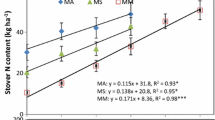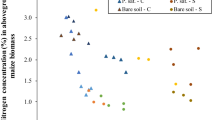Abstract
Dry matter yield and potential contribution of N, P and K of some woody perennials as well as performance of maize were assessed in an alley cropping system at the International Institute of Tropical Agriculture (IITA), Ibadan, Nigeria. Dry matter yield was highest forCassia, followed byGliricidia and theFlemingia. Whereas dry matter yields ofCassia varied significantly at the various pruning times, those ofGliricidia andFlemingia were relatively uniform.Gliricidia contributed the highest amount of N from the cutback (first pruning) and three subsequent prunings. Dry wood yield at cutback was 14.5, 6.8 and 29.7 tonnes/ha forGliricidia, Flemingia andCassia respectively. Coppicing rate was faster inGliricidia thanFlemingia andCassia. Maize height, stover and cob weights were reduced though insignificantly, for the maize rows close to the shrub hedgerows compared to those in the middle of the alleys. For the plots without N application and prunings removed, the maize near the hedgerows showed better performance than those in the middle of the alleys. The results indicate that N supplementation is needed in the alley cropping systems to optimize yield. The amount of N required is higher inFlemingia alleys than forGliricidia andCassia. Root growth of maize was found to be restricted in control plots without hedges; uptake of the major nutrients (N, P and K) was also found to be similarly affected in those plots.
Similar content being viewed by others
References
Agboola AA, Wilson GF, Getahun A and Yamoah CF (1981) Gliricidia Sepium: A possible means to sustained cropping. In: McDonald ed. Agroforestry in The Lowland Humid. Tropics. Proc. of a Workshop held in Nigeria — Ibadan. 27th April–1st May, 1981. p 141
International Institute of Tropical Agriculture (IITA) (1978) Annual Report 1977
International Institute of Tropical Agriculture (IITA) (1979) Annual Report 1978
International Institute of Tropical Agriculture (IITA) (1980) Annual Report 1979
International Institute of Tropical Agriculture (IITA) (1981) Annual Report 1980
International Institute of Tropical Agriculture (IITA) (1982) Annual Report 1981
International Institute of Tropical Agriculture (IITA) (1983) Research Highlights 1983
Kang BT, Wilson GF and Sipkens L (1980) Alley cropping (Leucaena Leucocephala (Lam.) de Wit) and maize (Zea mays L.) in Southern Nigeria. Plant and Soil 63: 163–179
National Academy of Sciences (NAS) (1980) Firewood Crops. Washington DC
Wilson GF and Kang BT (1981) Developing stable and productive biological cropping systems for the humid tropics. In: Stonehouse B (ed) Biological Husbandry: A Scientific Approach to Organic Farming. Butterworth London. pp 193–203
Author information
Authors and Affiliations
Rights and permissions
About this article
Cite this article
Yamoah, C.F., Agboola, A.A. & Wilson, G.F. Nutrient contribution and maize performance in alley cropping systems. Agroforest Syst 4, 247–254 (1986). https://doi.org/10.1007/BF02028359
Issue Date:
DOI: https://doi.org/10.1007/BF02028359




